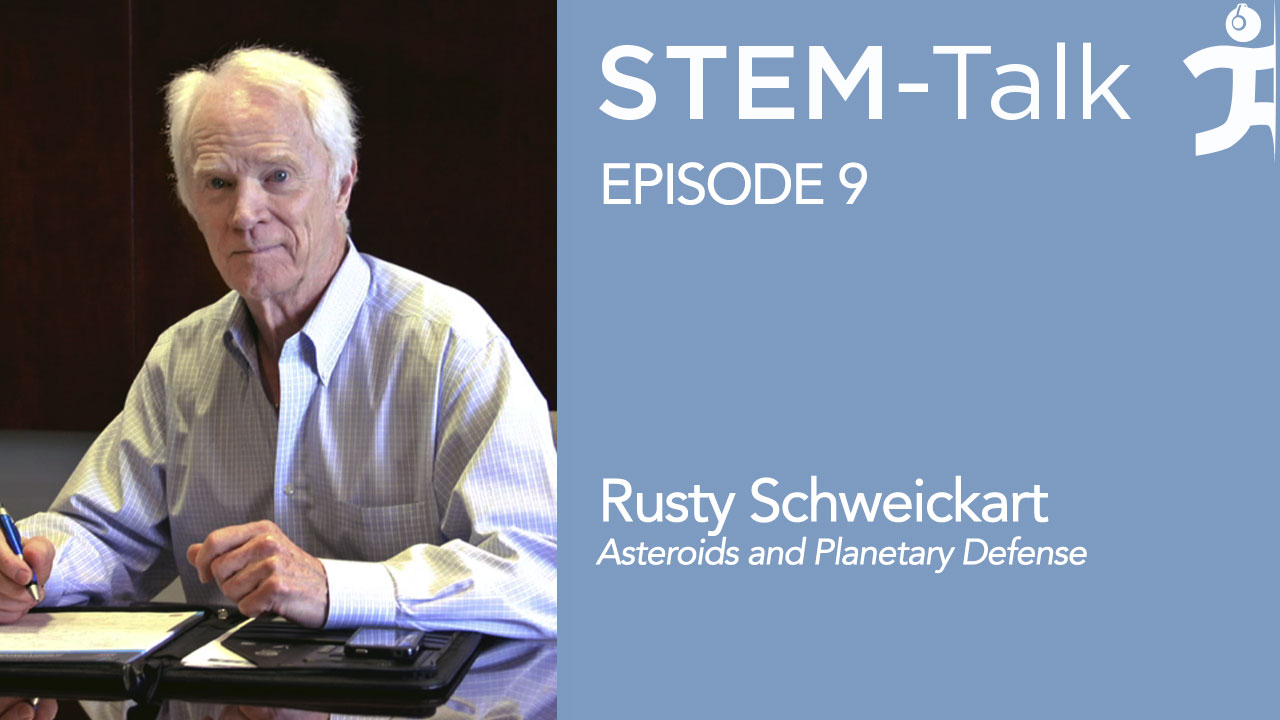STEM-Talk
Episode 9: Rusty Schweickart discusses asteroids and planetary defense
// Apr 26, 2016

Rusty Schweickart remembers when getting a man on the moon was at the top of the national agenda. JFK’s single minded decision to do that, according to Schweickart, “was perhaps the gutsiest, goal-setting episode in human history.”
And Schweickart was part of that—as the pilot of the first manned test of the lunar module, the lander portion of the spacecraft– during the Apollo 9 Mission in 1969. Schweickart also performed the first space-based test of the portable life support system and spacesuit that was used by the Apollo astronauts who walked on the Moon.
He was later the backup commander of the first Skylab mission in 1973, the first U.S. orbital space station. He served as Director of User Affairs at NASA’s Office of Applications, transferring NASA technology to the private sector. Most recently, he co-founded the B612 Foundation, a non-profit dedicated to defending the earth from an asteroid impact.
In this episode, Schweickart talks with veteran astronaut Tom Jones, also an IHMC senior scientist, about the potential threat of asteroids, the value of space-based asteroid-finding telescopes; and his contributions to getting the U.S. to the Moon in 1969.
Jones and Schweickart also discuss the importance of conveying the hazard posed by asteroids to the general public. The second annual “Asteroid Day” is on June 30th. For more information: http://asteroidday.org. For more specific information about asteroid hazards, check out: http://neo.jpl.nasa.gov/neo/groups.html
You can find more information on Rusty at his Wikipedia page: https://en.wikipedia.org/wiki/Rusty_Schweickart
Schweickart has given several lectures, including his IHMC lecture, “Deflecting an Asteroid:” https://www.youtube.com/watch?v=-VU5R-x24Wc.
1:18: Schweickart and Jones are both experts in planetary defense against asteroids. When IHMC Director (and STEM-talk co-host) Ken Ford chaired the NASA Advisory Council, Schweickart and Jones co-chaired a council task force for planetary defense. Schweickart also co-founded the B612 foundation, dedicated to the discovery and deflection of asteroids.
2:00: Ford and Jones served as strategic advisors to the B612 Foundation, and its current CEO, former astronaut Ed Lu, will later be interviewed on STEM-Talk.
2:18: Ford said the “sky is falling” syndrome may explain why this issue is not a political or public priority. It’s hard to get political leaders very excited about a potentially cataclysmic event that is certain to happen in the long run, but very unlikely in any given year.
3:23: Ford reads a 5-star iTunes review of STEM-Talk from “Ian”: “I liked the personal aspects of the interviews, and the science is explained at a good level: easy to follow, but not dumbed down.”
3:58: Schweickart talks about the Chelyabinsk asteroid that fell over Russia on Feb. 15, 2013. “It was a pretty good wakeup call. The official attention was relatively narrow and off-base, but the reality is that we have a lot of material now; in addition to that, there’s been some very good analysis showing that we learned a lot from the Chelyabinsk impact.”
6:00: Schweickart discusses the B612 Foundation’s Sentinel Mission, which will be an infrared space telescope orbiting the Sun interior to the orbit of Earth for the purpose of mapping the trajectories of asteroids that may pose a future danger to Earth. “Fundraising for a space telescope has never been done before; it’s a pioneering effort that we got involved in, principally because NASA had not been doing much. We took it on as a private initiative since the government seemed to be lagging a bit.”
8:27: Schweickart explains the importance of space-based telescopes. “Infrared is a very important aspect of these space telescopes that are being proposed. In space, an infrared sensor gives you an advantage. An asteroid is a hot object; it therefore glows in the infrared; the rest of the sky is extremely cold, so you are able to see objects shine very brightly.”
10:45: Schweickart talks about having a telescope between Venus and Earth. It’s a great perch for viewing near-Earth asteroids, but “The price you pay is that you end up very far from earth, and your communication problems/challenges are considerably greater than if you were one million miles from the earth.”
12:40: Schweickart says the NASA NEOCam (near-earth object camera) telescope and the Sentinel Space Telescope would both be a great addition to the overall asteroid armamentarium.
13:40: Smaller objects can only be seen from Earth when they are very close to whatever telescope you are using to look for them.
14:12: “There are about a million city-killer-sized asteroids in the inner solar system, and we’ve found about one percent or less of those. If you go down to the Chelyabinsk impactor size, there are about 10 million of those. We’ve found less than a tenth of one percent of those.”
14:43: “We’ve found a lot of objects that hit the earth every fifty years or so [statistically speaking], and we’d like to find those ahead of time.”
15:15: Schweickart says of the Sentinel Space Telescope: “We’ve calculated that in about ten years, we will find about a quarter of the 20-meter (asteroid) population; and 81% of the city-killer population (40-meter objects).”
16:33: “If you can take something the size of 300 Hiroshima bombs and prevent it from hitting…that’s really the goal. On the other hand, if you can get even a last-minute, hurricane-type warning (2-3 days, a week), even if you can’t prevent it from hitting, you could evacuate a local area, and save a lot of lives.”
17:50: Schweickart talks about the NASA-funded ATLAS (asteroid impact early warning system), following the 2008 entry of an asteroid over Sudan, which was discovered in space 19 hours before it struck Earth.
19:43: Commercial break: STEM-Talk is an educational service of the Florida Institute for Human and Machine Cognition, a not-for-profit research lab pioneering ground-breaking technologies aimed at leveraging human cognition, perception, locomotion and resilience.
20:02: Jones talks about being an astronaut: “To me, there’s an inescapable education that you get when you’re an astronaut. You can’t help but look down at the earth and see impact scars from past asteroid impacts: both small and large. You look up at the moon from earth orbit and the moon looks very crisp and clear, and it’s of course scarred by thousands and thousands of craters, covering one upon the other.” The goal of planetary protection naturally falls out of this vivid experience.
21:20: Schweickart says an asteroid impact is the only natural disaster we can potentially prevent. A sizeable asteroid hitting earth might happen only once in a person’s lifetime, and might fall unseen into the ocean. Yet this largely unseen hazard is real. “If we can use space technology to find these things, to predict an impact and to actually prevent an impact, you’ve gotta do it. That’s a slam dunk.”
23:10: ‘JFK’s goal of getting a man to the moon and back safely by the end of the decade…was perhaps the gutsiest, goal-setting episode in human history.”
24:00: Apollo 9 tested all of the key technologies needed for a lunar landing on the first flight of the lunar module. It also marked the first time the new Apollo space suit was used outside a spacecraft.
27:24: “You spend day after day, and week after week, simulating the things that you are going to do, and in particular, the critical things. In simulations, one thing after another is failing, and you are still trying to get back alive. You get a lot of confidence. The actual flight was much easier.”
29:01: Schweickart recalls testing the Hamilton Standard space suit for Apollo, which he says was far more flexible than previous versions used in the early spacewalks of the Gemini program.
29:40: “Being outside the spacecraft, that’s a real privilege. That’s when the view of the earth comes through to you; this incredibly beautiful planet that we live on; the atmosphere that forms that thin, iridescent blue band that separates this planet we live on from the blackness of space. You come to appreciate ‘mama.’”
30:41: In the mid to late 90s, NASA initiated its program in astrobiology.
31:45: “As soon as you start looking at the origins and history of life on earth, you cannot avoid [considering the effects of] past asteroid and comet impacts on the earth.”
33:35: Schweickart says the next year or so will be a very important time for funding telescopes that are critical to discovering asteroids that might threaten earth. The general public needs to support this issue.
34:20: The Asteroid Day Declaration calls on governments and space agencies of the world to launch an infrared space telescope so we can discover asteroids more rapidly.
34:55: We need to discover asteroids at a rate one hundred times higher than the pace at which we have been discovering them to date. On Asteroid Day, we are asking millions of people involved, to go onto the website, AsteroidDay.org, to sign the Declaration.
36:13: A valuable part of the last planetary defense conference in 2015 was to conduct an Asteroid Impact response exercise.
37:34: Jones said, “One of the biggest problems we face is human nature. How do we get people to plan early to respond to a future and very rare catastrophe so that we have an effective response when the time comes? I think the lessons [from this last exercise] were taken to heart.”
38:45: Schweickart said at that same conference, “national self-interest began to creep in and got in the way of cooperation.” Public confusion about an asteroid impact was also apparent.
42:04: You don’t know precisely where it’s going to hit until very late in the game.
43:40: If we decide to deflect an asteroid, the implications of that effort will affect many countries directly by changing the path of possible future impact points.
44:24: The UN is now on board to take this issue on as a geopolitical challenge.
45:45: The Association of Space Explorers played a key role in advancing UN discussions by commissioning a group of experts to make recommendations for cooperation on the asteroid hazard.
47:30: “For the first time, we are seeing a critical role for the general population to really speak out and insist that we take responsibility for the future of life here on earth.”
48:00: There are two good sources of public information on asteroids: at NASA, neo.jpl.nasa.org (about asteroid hazards); asteroidday.org for information on asteroid day, which is June 30th.
48:34: Tom Jones thanks Rusty Schweickart and signs off.
48:43: STEM-Talk host Dawn Kernagis and co-host Ken Ford briefly discuss episode and invite listeners to visit the STEM-Talk webpage: stemtalk.us
49:10: Dawn Kernagis and Ken Ford sign off.






